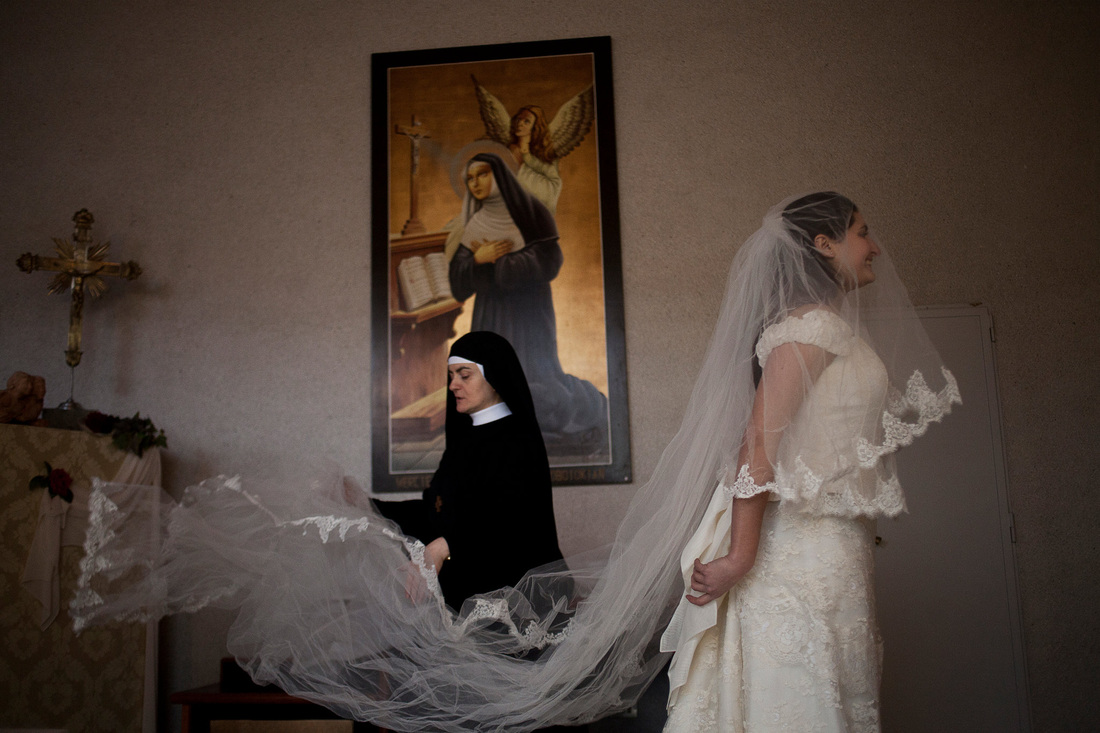“If you have a dream and we can make it come true, we’ll do our best,” said Sister Maria Laura, a cloistered Augustinian nun and onetime seamstress.
In a country synonymous with designer fashions, Sister Maria Laura runs one of Italy’s most unlikely ateliers at the St. Rita monastery, a medieval complex perched in the central Umbrian hills.
In the process, the atelier has become a full-time job for Sister Maria Laura, who oversees an expanding collection of donated wedding gowns — now numbering in the hundreds — in various sizes, train lengths and styles (though white and its pale variations still dominate the color scheme).
The monastery — once home to St. Rita, an abused bride and a widow before becoming a nun about 600 years ago — has long been a pilgrimage site for Italian women, who come to pray to the saint to protect their marriages. The collection, as it were, began when some women brought their wedding dresses as an offering of thanks.
Brides-to-be arrive every week at the monastery, often accompanied by their mothers and sisters, as if they were visiting a wedding showroom.
“If I can’t find it here, I simply can’t afford to buy one,” Chiara Cariolato, 21, who comes from a family of six, said anxiously on a rainy Sunday morning, as she walked through the monastery’s garden of roses, the flower traditionally associated with St. Rita.
Sister Maria Laura sees brides only by appointment. Ms. Cariolato, her sisters and friends left their hometown in northern Italy at 3 a.m. to reach the monastery in time. Though she had never walked into a bridal dress shop, Ms. Cariolato envisaged herself walking down the aisle this May in a white bodice decorated with pearls and a flowing gown.
“I think I look like Jane Austen,” Ms. Cariolato said to her sisters, who seemed unconvinced, before glancing at her reflection in the mirror. She wore a tight top with puffed sleeves and an ocher gown with a long train.
Sister Maria Laura smiled, then swiftly began picking out alternative dresses. The atelier was revamped in October to keep pace with the increasing demand.
“I know which one she will take; you can tell from their faces,” she whispered conspiratorially.
She is also quite straightforward. “No need to tighten it; you don’t want to look like a sausage on your wedding day,” she might say. “This is just ugly,” she bluntly told two blushing brides one chill January morning.
But Sister Maria Laura says she manages to find the right gown for almost every bride. It’s the rush of emotion that comes with the right match that she loves most about the work she does.
Though Italy is struggling through an economic downturn, expectations — both financial and emotional — about weddings remain high. It’s “incomparable to elsewhere in Europe,” said Giuliana Parabiago, editor in chief at the magazine Vogue Bridal Italy.
Though traditional marriage ceremonies are on the decline in this historically Roman Catholic country, with the number of weddings dropping by 16 percent from 2005 to 2012, according to Istat, the national statistics agency, loans requested for weddings went up by 41 percent in the past two years, market research shows.
“Ooh, I feel like Princess Sissi in this one,” Irene Berardi, a 25-year-old bride, shrieked, twirling in a white tulle gown and embroidered corset, with white silken gloves up to her elbows. The reference was to a popular 1950s film version of the life of the Empress Elisabeth of Austria. “We’d need a castle for the reception, but we’re actually thinking about a farm.”
Ms. Berardi and her boyfriend never dreamed of a lavish wedding, she said. That felt to them like a slap in the face of the many people in the world who are starving and suffering. So when one of her girlfriends enthusiastically told her of her visit to Sister Maria Laura, Ms. Berardi decided to email the monastery and request an appointment.
It took a few hours of laughter and giggling to find the dress of her dreams, and she warmly hugged Sister Maria Laura at the end, slipping her an envelope with her donation.
But choosing her dress at the St. Rita monastery was not merely an economic transaction, Ms. Berardi explained. “I’ve felt at home here from the very first minute,” she said. “After all, nuns have a calling. Love is a calling, too.”
http://www.nytimes.com/2014/02/12/world/europe/an-italian-monastery-becomes-a-fashion-destination-for-brides-in-a-frugal-era.html?emc=eta1





